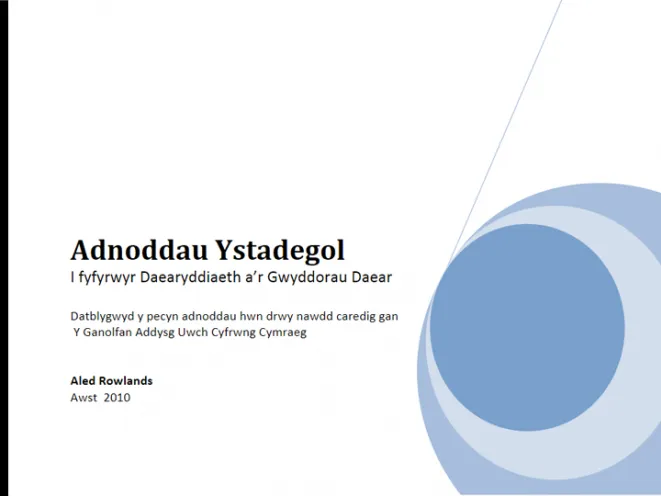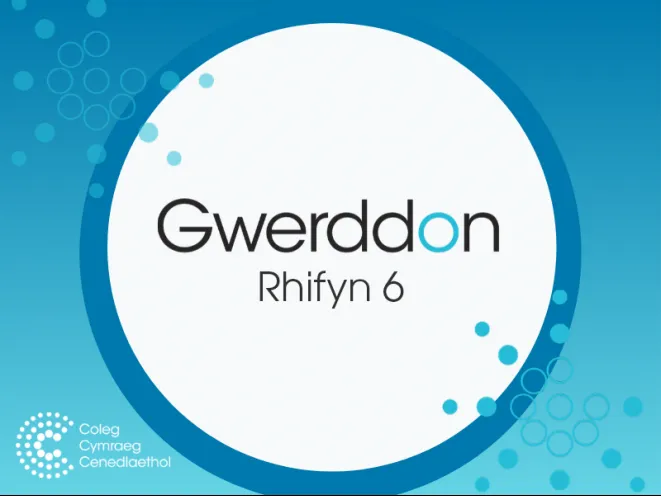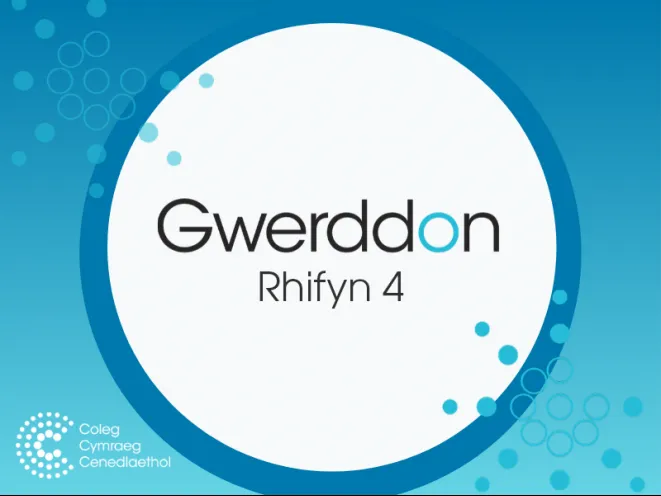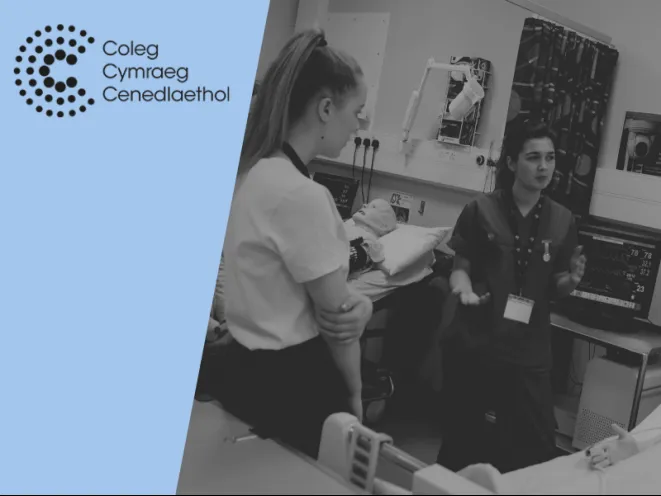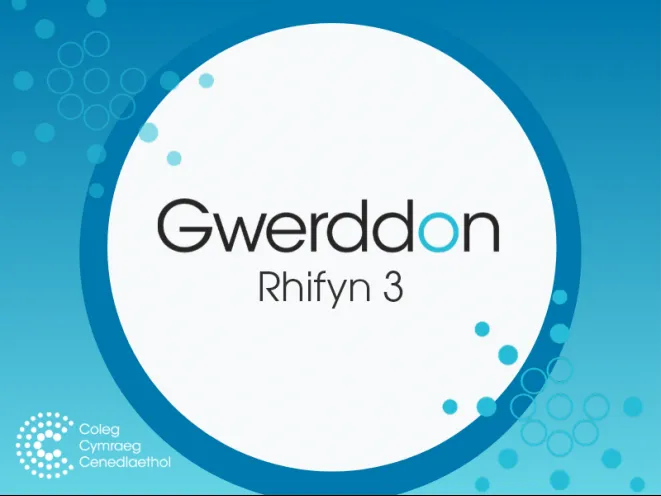A resource pack including examples of how to use statistical techniques in an undergraduate thesis. It contains 12 self-training chapters for second-year students, including: the use of appropriate resources and data, instructions on how to use a Geographical Information System (GIS). The package includes a handbook and data files.
Statistical Resources for students of Geography and Earth Sciences
'Towards the light': Parents’ reasons for choosing Welsh education for their children in Cwm Rhymni
Welsh-medium education has long been seen as an effective language planning tool in order to transmit the Welsh language in Wales. According to the 2001 Census, there has been a substantial increase in the numbers of Welsh speakers 3–15 years old, especially in south–east Wales, since the 1991 Census. The aim of this paper is to elaborate upon this quantitative data by providing qualitative data with regard to the main reasons and incentives for parents to choose this educational option for their children. The study location is Cwm Rhymni, Caerffili county. A combination of quantitative questionnaires and qualitative in-depth interviews were administered amongst parents from the meithrin, primary and secondary school sectors in Cwm Rhymni. The reasons why parents choose this educational system for their children were cultural, educational, economic and personal. However, it is pertinent to note from the outset, that the parents chose Welsh-medium education for their children in this area for mainly cultural reasons, rather than economic reasons which featured heavily in past studies such as research by Williams et al. (1978) on bilingual education in the Rhondda. This study is the first in a larger corpus of work and one that hopes to address the existing lacunae in the Sociology of Language in Wales, especially as there is a lack of Sociology of Language studies through the medium of Welsh in Wales.
Welsh as a job requirement: An acceptable step from a liberal perspective?
Welsh as a job requirement: An acceptable step from a liberal perspective?
Policies introduced to revive the prospects of minority languages have often been the source of substantial disquiet. At times, objections to these policies are expressed in moral terms, with certain measures being accused of transgressing normative principles such as individual freedom and equal opportunity. Given their nature, these moral objections pose interesting questions for liberals. Therefore, how should liberals respond? This article will explore this question by focusing on one controversial aspect of language policy in Wales: the steps taken to set Welsh-language requirements for some jobs in the public sector. This is a practice which has generated substantial debate, with opponents claiming that it undermines the liberal commitment to equality of opportunity in the field of employment and, in particular, transgresses the principle of appointing on the basis of merit. Do such arguments stand up to scrutiny? Do minority language requirements in the field of employment go beyond what liberals would consider acceptable, or can a coherent defence that is clearly rooted within a liberal framework be developed?
The love-songs of Iolo Morganwg, with particular reference to 'Y Ferch o'r Scerr' ('The Lady of Sker')
The manuscripts of Iolo Morganwg (1747-1826), as well as his collection of native folk-songs, give us a unique insight into an important period in the history of Welsh culture during the eighteenth and nineteenth centuries. The central focus of this study is the love-songs found in his collection, together with the wider social context and background which serve to underpin the folk songs. One can trace this tradition to the poets of the nobility, and especially to the age of Dafydd ap Gwilym. Also one folk-tune in particular will be discussed in detail, ‘The Lady of Sker’. The love story, the folk-tune and the words which are normally associated with ‘The Lady of Sker’ are all well-known in several circles, however the folk-tune recorded by Iolo is totally unknown.
Historical climate: The potential of Wales’s documentary sources
With the uncertainty of climate change, reconstructions from parameteorological and phenological records provide a strong basis for the analysis of past and present climate. However, very little research has been completed on the historical climate of Wales, which is variable throughout the country due to factors such as topography and atmospheric circulation. This is particularly so for west Wales, which has a diverse range of environments from the upland ‘green desert’ to the fertile coastal plains, where an extensive history may potentially be reconstructed from un-tapped documentary resources. The potential is immense as possible sources of meteorological information include all religious, official and personal documentation, which may provide an insight into the relationship between the Welsh and the weather.
‘Kaleidoscopic Variety’: Bilingual education in Wales today
Bilingual education (i.e. Welsh and English) occurs widely in Wales. By now, considerable variation exists in the provision of bilingual education and, as in the case of minority languages in other European regions, bilingual education in Wales is a combination of education in language heritage/ maintenance (1st Language Welsh) and immersion education (2nd Language Welsh). Because the bilingual education throughout Wales is characterised by “kaleidoscopic variation” (Baker 1993:15), teachers use a wide variety of teaching methods and bilingual teaching. Following interviews / observations at bilingual secondary and primary schools throughout Wales during 2007-2009, this paper will explain the aims and methodology of the research project in question, before moving on to discuss some initial findings. Specific reference is made to purposeful concurrent use of language, as teachers use both languages concurrently during the lesson. The conclusion is reached that further research is necessary into the 'kaleidoscopic variation' of bilingual educational practice in schools in Wales, as well as the analysis and evaluation of the bilingual teaching modules which were observed.
Woyzeck Büchner, Peter Szondi and the crisis of drama
In this article Myfanwy Miles Jones analyses Büchner’s portrayal of the central character’s developing psychosis in the light of R. D. Laing’s existential psychiatric theory. Observing the progressive nature of Büchner’s dramatisation of the depth and coplexity of the human mind in turn reveals the formal limitations of drama in the Nineteenth Century. Setting Woyczeck in the context of Szondi’s formal analysis of modern drama, the article argues that Büchner’s treatment of madness casts new light on the formal development of modernist drama and argues that the fact that the play is unfinished is an inevitable consequence of the project itself, given that the formal resolution of the dramatic situation required the existence of conditions which had not at that time come into being.
'Y Wladfa: Settlement without colonisation?' Geraldine Lublin (2009)
This paper offers a fresh analysis of a number of aspects of Y Wladfa, the Welsh settlement in Patagonia, by bringing into the discussion the notion of ‘liminality’ as interpreted by postcolonial theory. After providing some historical background of the settlement that takes full account of the Argentinean perspective, we set out to explore the pronounced duality characteristic of the Welsh pioneers in Chubut in their stance as virtual colonisers and colonised. This double consciousness, which can be traced back to the very origins of the Fenter Fawr, is studied both in a general context and with particular reference to the complex relationship that developed between the Welsh immigrants and Patagonia’s original peoples.
Faith’s reaction to modern science
A version of this article appeared originally in The SCM Core Text on World Christianity in the 20th Century, co-authored with Dr Martin Conway (London: SCM Press 2008). Having set the debate between Science and Christianity in its historical context, it explores a range of contemporary scientific questions such as Quantum Theory and Relativity, Cosmology, The discovery of DNA, Genetic Manipulation and Advances in Medical Treatment. The final section examines Roman Catholic responses, Evangelical and fundamentalist approaches and ecumenical responses to some of these key issues. The article concludes by affirming that an engagement between Christian theology and contemporary developments in science is essential if the contemporary articulation of faith is to have meaning and coherence.
Pecyn Rhyngweithiol ar gyfer Nyrsio
Rhaglen ryngweithiol wedi ei seilio ar Bapur Briffio LLAIS: Ymwybyddiaeth o Iaith mewn Ymchwil Iechyd a Gofal Cymdeithasol.
The effect of recent changes on the linguistic uniqueness of Welsh
The Welsh language has several features in its grammar which are crosslinguistically very unusual. This paper looks at five such features, at their rarity in the languages of the world and at their place in Welsh grammar. It shows that the textual frequency of each feature, in corpora of spoken and written Welsh, is declining. These five features, which had been stable in Welsh since the earliest records well over a thousand years ago, have in the lifetime of older speakers become optional or obsolescent in the spoken language: the grammar of the language has changed. Welsh is likely changing because of bilingualism. Along with the recent increase in the public use of Welsh has come an increase in the use of English in the everyday lives of Welsh speakers. The average Welsh-speaker now speaks more English than Welsh, outside the family at least. Speaking a second language fluently and regularly HAS been shown to affect the speaker's first language, probably to lessen the psychological load in constantly switching between the two languages. It is argued that in such a situation cross-linguistically unusual features are inherently more susceptible to loss. Finally, the paper looks very briefly at possible future developments.
The geomorphology of Wales’s rivers: Today, yesterday and tomorrow
This paper presents a review of the fluvial geomorphology research undertaken on Wales’ rivers. As well as discussing trends seen in these studies, by firstly focussing on the work of geologists of the late nineteenth century, and by progressing through the development of geomorphology as a research field to the present interdisciplinary period, the fields that have received particular attention on Welsh rivers are discussed. These include the evolution of the mega-geomorphology of Wales, innovative process studies, the evolution of alluvial fluvial systems to short- and long-term climatic changes, and the response of Welsh rivers to anthropogenic activity. This range of studies is a result of the nature of Welsh fluvial systems. Firstly, they display an evolutionary history including glacial periods and rejuvenation. Secondly, contemporary processes have created a wide range of channel types, including bedrock channels, gravel bed rivers, meandering, braided, stable and unstable channels. Thirdly, academic interest and pragmatic concerns regarding river management have led to a large body of work that has, in some cases, led to many reaches on Welsh rivers being classed as international archetypes. Gaps in our knowledge are also discussed. These include the need to increase our understanding of contemporary process and to continue the work done on alluvial response and evolution through using the latest techniques to constrain the chronology of fluvial system development. There is a need to extend the spatial scope of our studies to areas which have not received as much attention in the past such as the bedrock and mixed bedrock-alluvial channels of the north-west and the south Wales valleys.

